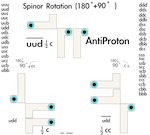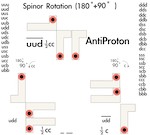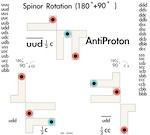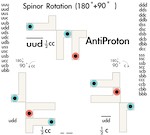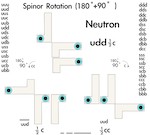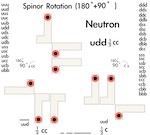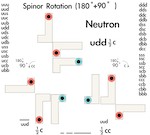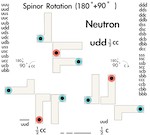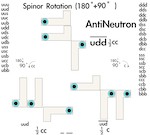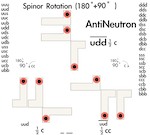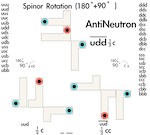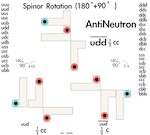Spinor Rotation of I / L quark composites
What are the stable particles?
__BOSONS__ | __FERMIONS__
ɣ ɣɣ ʆʆ g e⁻ ν̅ℯ p⁺ n⁰
Why?
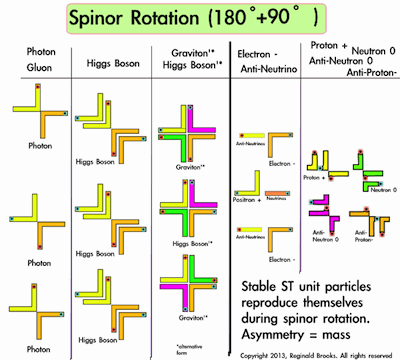
Stable particles spinor rotate (SR) back to themselves...
occupying the most energetically stable...and, thus, favored...
ST configuration space (Favored space: +OV+AV & -OV-AV).
Why do these fermions have mass...these bosons do not?
______BOSONS______ | ______FERMIONS______
SR symmetry SR asymmetry
Their symmetry gives Their asymmetry forces them to SR
them full ST quantum into "kin" (brother-sister) forms and,
movement with each thereafter, back to their original
pulse-propagation (P-P). ST form.
Why do the massless bosons always travel at lightspeed...
massive fermions never?
______BOSONS______ | ______FERMIONS______
All P-P energy goes to Portions of their P-P energy is
full spatial extension diverted to morphing into and out of
(displacement). "kin" forms...so they can NOT
experience full spatial extension...
and, as slowed light...they overlap
the same ST...and that equals mass.
What about charge and spin?
Massless particles never have a net charge and their spin is
always integral (0, 1, 2).
Massive particles may have fractional charge (⅓,⅔), as L-quarks...
or integral charge (0, -, +, ++), as leptons/baryons (fermions) or
mesons/W/Z (bosons). Fermions spin=½,3/2 and bosons spin=0,1,2.
Why are the other non-stable bosons (mesons and W/Z) massive...
traveling a sub-lightspeed?
They all contain L-antiquarks which occupy less energetically
favored states. Even when paired with their equal and opposite
L-quark partners, they always have...even after SR...the
unfavored antiquark position.
Also, being composed of two fractionally-charged L-quarks,
a greater degree of Formation-Vector (F-V) asymmetry is present.
These combined attributes give them increased mass, slower
travel speed and a shorter lifespan than their stable counterparts.
Same question for the other non-stable baryons and leptons?
The Delta (∆⁻ ⁰ ⁺ ⁺⁺) set of unstable particles looks almost identical
to the p⁺, n⁰, p̅⁻, n̅⁰ ...only they are on steroids, with double the
number of particle/antiparticle pairings...and all with spin 3/2
instead of spin ½. And like their stable, lighter counterparts, SR
generates a "kin" that generates a "kin" that returns to the original
particle. So why the heavier mass and shorter lifetime? The only
difference is spin 3/2 versus spin ½.
Since mass, speed and lifetime (lifespan, stability) are all critically
dependent on the particular symmetry/asymmetry F-V configuration
and resulting SR symmetry/asymmetry, apparently the extra spin
(3 x ½ = 3/2) is a less energetically favored ST resulting in a
further slowing in lightspeed...more of a spinning-in-place action
resulting in a larger expression of mass and a shorter lifespan.
The muon and tau leptons occupy increasingly less-favored ST space.
What about the neutrino/antineutrino?
As pure spin ½, charge 0 and mass 0 (or tiny), they probably SR
into various flavors...perhaps slowing a bit in the less-favored
muon and tau forms.
This slowing may represent a transient small-mass expression...
almost as an anomaly as they have no net angular configuration
of its F-V to represent true mass.
Helpful I and L Quark Reference Charts and select images from L.U.F.E. and The LUFE Matrix follow the gallery. The home page for Quark Portraits is here.




